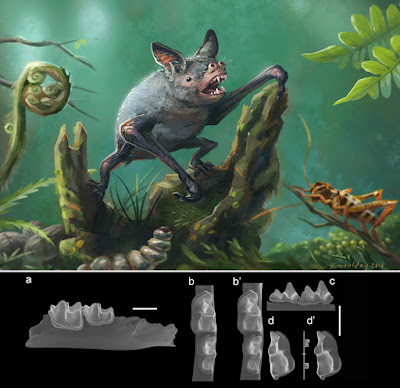 |
| [upper] Mystacina robusta (Dwyer, 1962)
[lower] Vulcanops jennyworthyae
Hand, Beck, Archer, Simmons, Gunnell, Scofield, Tennyson, De Pietri, Salisbury & Worthy, 2018
|
Abstract
A new genus and species of fossil bat is described from New Zealand’s only pre-Pleistocene Cenozoic terrestrial fauna, the early Miocene St Bathans Fauna of Central Otago, South Island. Bayesian total evidence phylogenetic analysis places this new Southern Hemisphere taxon among the burrowing bats (mystacinids) of New Zealand and Australia, although its lower dentition also resembles Africa’s endemic sucker-footed bats (myzopodids). As the first new bat genus to be added to New Zealand’s fauna in more than 150 years, it provides new insight into the original diversity of chiropterans in Australasia. It also underscores the significant decline in morphological diversity that has taken place in the highly distinctive, semi-terrestrial bat family Mystacinidae since the Miocene. This bat was relatively large, with an estimated body mass of ~40 g, and its dentition suggests it had an omnivorous diet. Its striking dental autapomorphies, including development of a large hypocone, signal a shift of diet compared with other mystacinids, and may provide evidence of an adaptive radiation in feeding strategy in this group of noctilionoid bats.
Systematic palaeontology
Order Chiroptera Blumenbach, 1779
Suborder Yangochiroptera Van den Bussche & Hoofer, 2004
Superfamily Noctilionoidea Gray, 1821
Family Mystacinidae Dobson, 1875
Vulcanops jennyworthyae gen. et sp. nov.
Stratigraphic and geographic distribution: Lower Miocene of Central Otago, New Zealand.
Etymology: From Vulcan, mythological god of fire and volcanoes (Roman), and ops, a suffix commonly used for bats; in reference to New Zealand’s tectonically active nature, as well as to the historic Vulcan Hotel, centre of the hamlet of St Bathans, from which the fauna takes its name. The species name honours Jennifer P. Worthy in recognition of her pivotal role in revealing the diversity of the St Bathans Fauna.
 |
| The fossil dig site at St Bathans in New Zealand where the fossilised remains of an extinct giant burrowing bat, Vulcanops jennyworthyae, were found.
photo: Trevor Worthy.
|
 |
| Washing of St Bathans sediments through sieves in Manuherikia River in New Zealand to collect fossil bones and teeth of an ancient burrowing bat.
photo: Vanesa De Pietri.
|
Suzanne J. Hand, Robin M. D. Beck, Michael Archer, Nancy B. Simmons, Gregg F. Gunnell, R. Paul Scofield, Alan J. D. Tennyson, Vanesa L. De Pietri, Steven W. Salisbury and Trevor H. Worthy. 2018. A New, Large-bodied Omnivorous Bat (Noctilionoidea: Mystacinidae) reveals Lost Morphological and Ecological Diversity since the Miocene in New Zealand. Scientific Reports. 8, Article number: 235. DOI: 10.1038/s41598-017-18403-w
Giant extinct burrowing bat discovered in New Zealand phy.so/434803633 via @physorg_com


